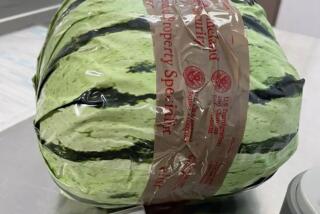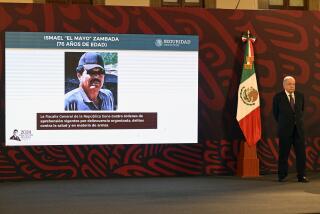Cocaine Haul in Tijuana Valued at $331 Million
U.S. Drug Enforcement Administration officials confirmed Friday that Mexican authorities confiscated at least 1.2 tons of cocaine this week in Tijuana, yielding what may be the largest seizure of narcotics ever along the international border.
The cocaine, which samples show to be 96% pure, has a street value of about $331 million, said DEA spokesman Ronald J. D’Ulisse.
D’Ulisse said the DEA was contacted about the huge drug find Thursday by Mexican narcotics officials. The Mexican agents told their American counterparts they seized 2,455 to 2,555 pounds of the high-grade cocaine between 7 and 8 p.m. Tuesday at an undisclosed address in Tijuana.
Eight Mexican nationals were arrested in Tijuana in connection with the case. They were Anselmo Chaidez, Marcelino Morales, Ozvaldo Quinonez-Lopez, Rogelio Beltren-Medina, Rogelio Roman-Villareal, Hector Andres, Domingo Uriarte-Nunez and H. Mesa. Ages for those arrested were not available Friday.
Two of the men arrested--Morales and Uriarte-Nunez--are from the town of Badiraguato in the state of Sinaloa, the birthplace of Rafael Caro Quintero, who is under arrest in connection with the 1985 kidnaping, torture and slaying of DEA Agent Enrique Camarena, DEA agents said.
Officials are not certain if the Tijuana arrests are part of a larger, international drug ring. But Diogenes Galanos, DEA special agent in San Diego, said he suspects that the drugs are part of an “organization” backed by plenty of money.
“We’re talking millions of dollars,” Galanos said.
While narcotics agents in both countries expressed happiness about the seizure, they differed on what led the Mexican officials to the cache. The Mexican officials said leads developed through their own sources led them to the address.
But DEA authorities Friday took part of the credit. They said the large seizure resulted from a smaller arrest they made at 10 p.m. Tuesday of two women who were trying to smuggle 80 pounds of cocaine over the border in the trunk and engine compartment of a sports car. That amount of cocaine has a street value of $10 million.
Mexican officials, however, said they seized the cocaine between 7 and 8 p.m. Tuesday, so the arrest of the two women by U.S. authorities later Tuesday night had nothing to do with Mexican agents finding the huge cache.
The two women--Veronica Nava-Morena, a nursing assistant, and Argentina Armendariz-Rodeles--were booked at the Metropolitan Correctional Center on charges of suspicion of drug smuggling. Both are 20 and are from Chula Vista.
Bail was set at $250,000 for Nava-Morena. Armendariz-Rodeles is being held without bail, a federal spokeswoman said. Both face 20 years in prison and a $250,000 fine.
Galanos said DEA agents in San Diego learned enough from the smaller arrest to call Mexican officials and tip them to the location of the larger cache. Cocaine found by the Mexican agents was packaged the same way as that confiscated from the two women at the border, he said.
“The packaging is identical,” said Galanos. “The numbers on the packages jibe. It’s the same.”
The drugs were packed in round plastic boxes and wrapped in beige masking tape. On each package, which one DEA official said looked like “a loaf of health bread,” C-14 was written.
D’Ulisse said the DEA has information indicating that at least some of the 1.2 tons confiscated was headed for distribution from San Diego.
Other large drug busts made within the last two years in Southern California include 1,100 pounds seized on the highway between Tecate and Tijuana a year ago and 400 pounds of cocaine taken from the site of a plane crash in the San Bernardino desert two years ago. In June, 1984, agents confiscated more than two tons of marijuana in San Diego County.
The 1.2 tons of cocaine seized Tuesday apparently was being moved along what authorities say is a popular Colombia-Mexico-U.S. route. This route is being used more by smugglers because of the ease in storing large quantities of drugs in Tijuana, which are then moved little by little across the border, D’Ulisse said.
“Tijuana is a storage depot . . . a warehouse,” D’Ulisse said. “They can nickel and dime us. . . . “
More to Read
Sign up for Essential California
The most important California stories and recommendations in your inbox every morning.
You may occasionally receive promotional content from the Los Angeles Times.










